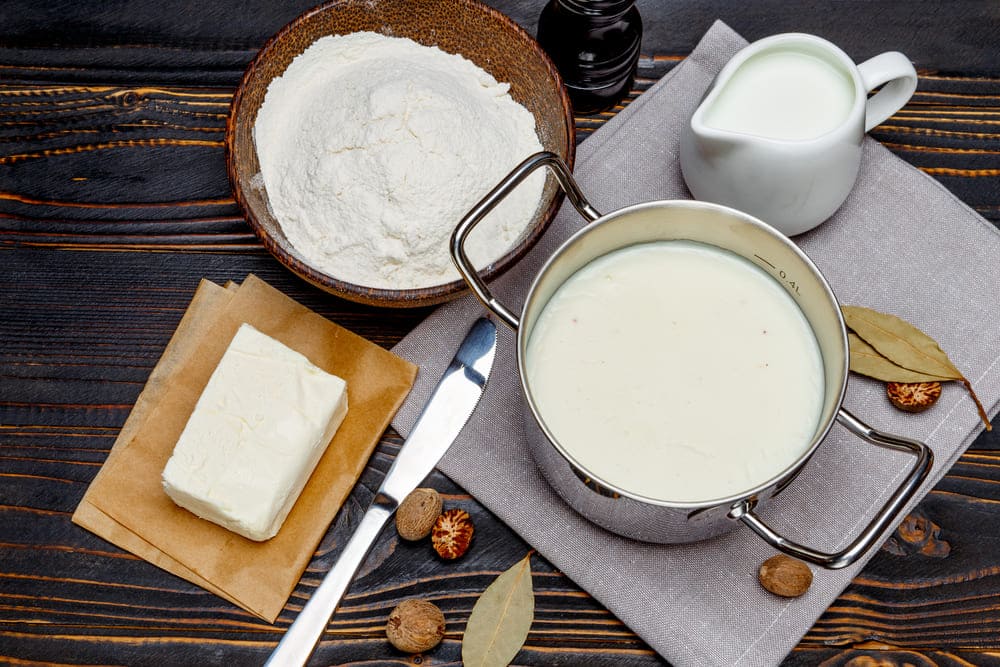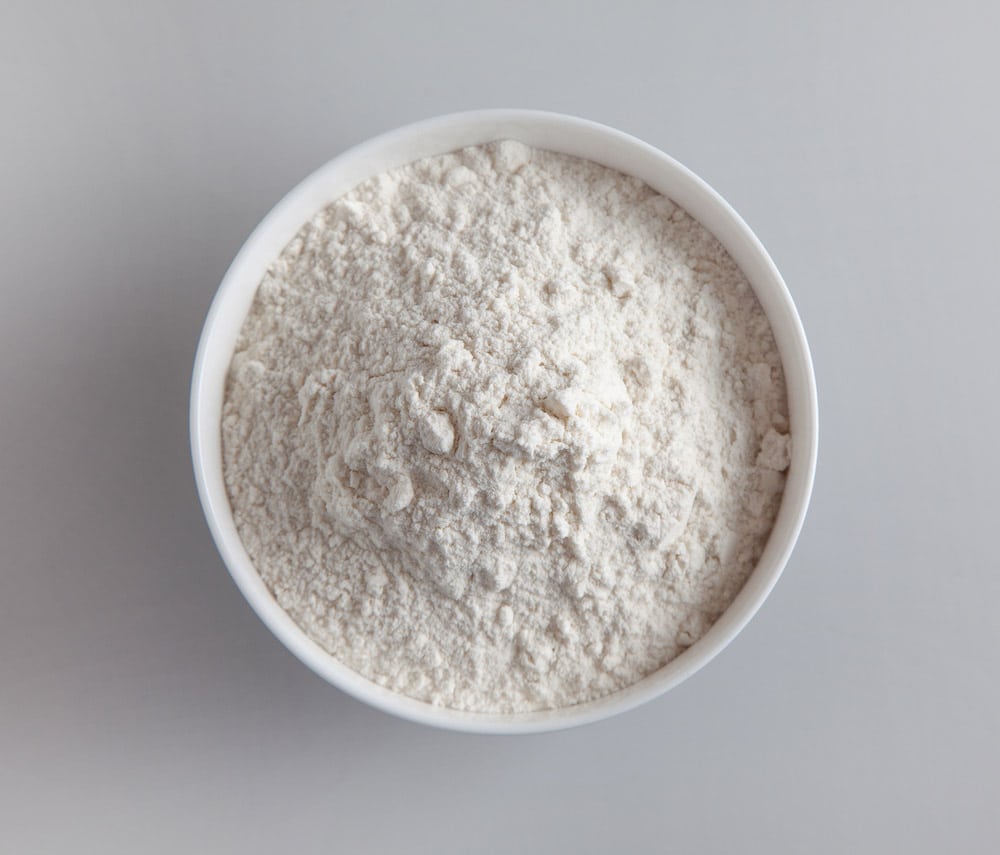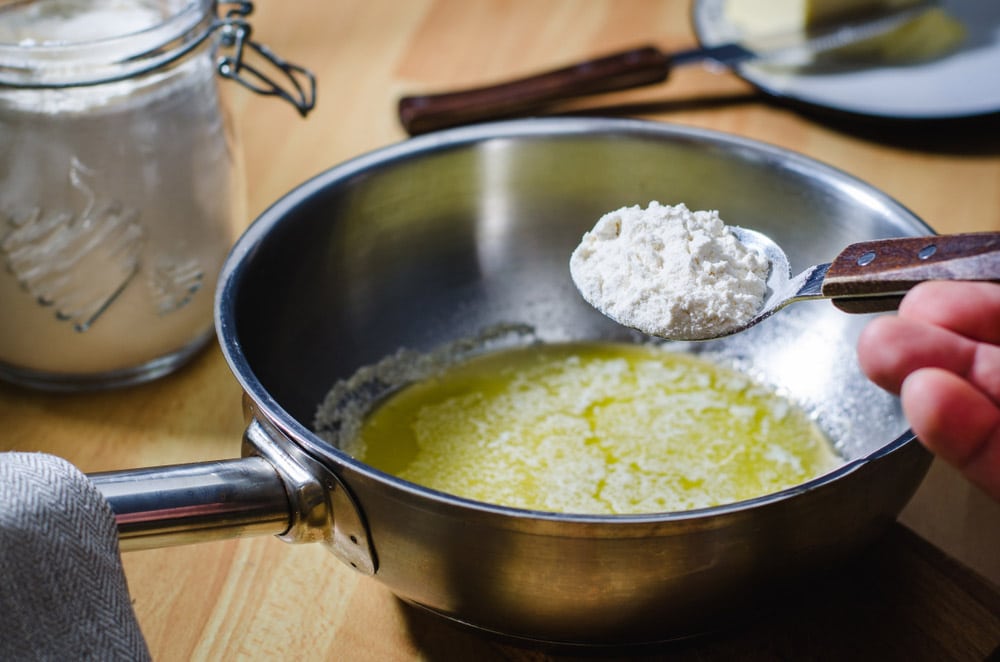
A roux is used to thicken and add richness to so many recipes that it’s something every home cook should master.
While the ingredients are simple – some type of fat such as butter or goose fat and flour, it can be difficult to know how much of each to use.
Here, we provide the correct ratio for you plus give some tips and interesting information.
What Is A Roux?
Roux is a French word and is pronounced “ru”. It is a mix of flour and butter or other fat cooked together until thick and sometimes dark. It is used to thicken sauces and gravies. It is made by adding equal parts of flour and fat.
Therefore, the correct butter-to-flour ratio for a roux is 1:1. The butter is heated on the stovetop in a small saucepan and the flour is added to the melted butter. While this may seem remarkably simple, many people struggle to make a good roux.
What’s It Used For?
A roux thickens and provides creaminess and density to soups, gravies, and sauces. It also helps other fatty ingredients like cream to stay in suspension in the dish instead of floating to the top.
To make white or cheese sauce, milk is whisked into the roux. To make gravy, some stock is beaten into the roux.
Tips From The Pros
- Be sure to use a bland, neutral fat like vegetable or canola oil or unsalted butter.
- Cook the flour and the butter, stirring, until there is no raw flour smell left.
- If you are using butter, there should be a nutty, biscuity smell as the milk solids brown. As soon as it gets to this point, lower the heat to prevent burning and begin whisking your liquid in gradually.
- Use hot milk or stock rather than cold.
- Whisk constantly to prevent burning and lumps from forming.
- Different recipes call for different degrees of doneness. A white roux is needed for bechamel sauce that’s used in things like mac and cheese and lasagne. The fat and flour are cooked just until the raw flour disappears, no further. This usually takes about 4 minutes. A blonde roux must be cooked for a little longer and is often used for darker sauces like turkey or duck gravy. A dark brown roux is often used for Cajun food. It is better to use oil than butter for a dark roux as butter will probably burn.
What Should Be the Butter-to-Flour Ratio in a Roux?
Short answer: Use equal amounts of each.
You have to be fair when adding both ingredients while making a roux for your dish. Otherwise, it can end up either too dry or too liquid.
Many people use digital/kitchen scales to measure the exact mass of both the ingredients and be accurate with their recipes. However, you can also use your regular measuring cup to measure liquid butter and flour.
One thing that you should keep in mind is, there is a variety of butter in the market, and you have to use them with different ratios when making a roux. If you are not using clarified butter, which is pure butterfat, then you must add less flour to the mixture.
You can be accurate by doing quick maths, for example, if you add 57 grams of melted butter and you know that 15% water that comes with your non-clarified butter will cook-off leaving 48 grams, you must add flour according to this 48 grams.
What Does the Flour Do?
The flour works by absorbing the equal weight of butter into it, giving the mixture a creamy, smooth texture. Flour is also the thickening agent in the mix.
Flour also gives a mild and grain-like taste to your gravy. When it’s cooked, the raw flour flavor goes away.
What Does the Butter Do?
The fat that is most commonly added to a roux is butter because it works perfectly with flour, providing the required taste.
Clarified butter is preferred because it comes with water and milk solids removed from it so is less likely to burn. It has a better capability of combining with flour as well.
We hope this article helps you to master this very important kitchen staple. If you keep the ratios right and follow our instructions, you will have a beautifully smooth roux in no time.

